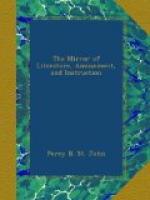There are nearly eighty cuts in the present volume—many from specimens, all from excellent authorities, and of any but common-place character.
* * * * *
TOMB OF PAUL AND VIRGINIA.
Junior lieutenants and midshipmen, and others of the age of romance, always make it a point to visit these tombs as soon as possible after their arrival. If they can only get on shore for a few hours, they hire or borrow horses, and proceed with all haste to the interesting scene. On reaching the spot to which they are directed, they enter a pretty garden, laid out with great care, and are conducted along a walk bordered with bushes, bearing a profusion of roses, and having a stream of the clearest water flowing on each side. At the end of this walk the visiter sees a red, glaring monument, which he is told is the tomb of Virginia; at the termination of a similar avenue, on the opposite side of the garden, appears another monument, exactly resembling the first, which is designated the tomb of Paul: a grove of bamboos surrounds each. The traveller feels disappointed on beholding these red masses, instead of elegant monuments of Parian marble, which would seem alone worthy of such a purpose and such a situation. But that is not the only disappointment destined to be experienced by him: after having allowed his imagination to depict the shades of Paul and Virginia hovering about the spot where their remains repose—after having pleased himself with the idea that he had seen those celebrated tombs, and given a sigh to the memory of those faithful lovers, separated in life, but in death




